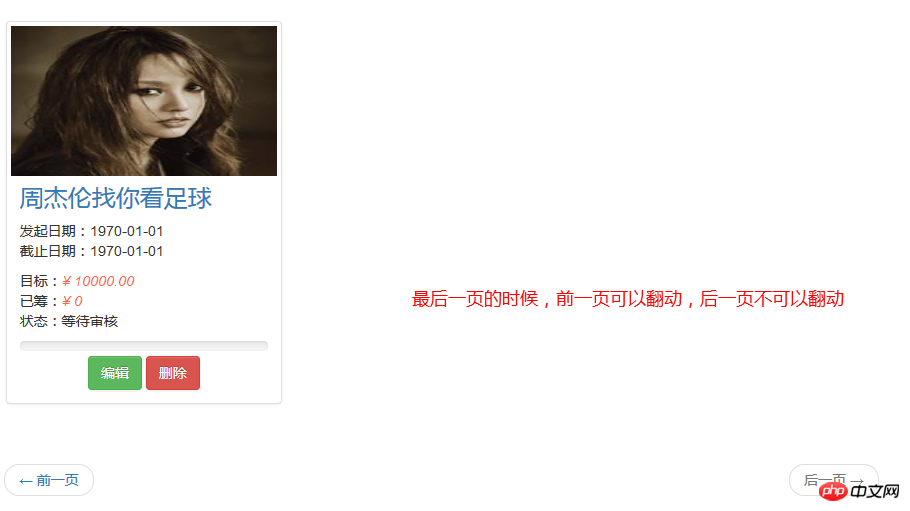
Bootstrap, from Twitter, is a very popular front-end framework. Bootstrap is based on HTML, CSS, and JavaScript. It is simple and flexible, making web development faster. This article mainly introduces Bootstrap to achieve page turning effect in detail, which has certain reference value. Interested friends can refer to it.
Advantages:
Supports partial refresh;
As long as it is a list, the component can be loaded;
Supports dynamic data binding;
Of course And absolutely simple and practical.
Rendering
At the last page:

At the first page:

Implementation
①、Layout of page turning component
<%@ page language="java" contentType="text/html; charset=utf-8" pageEncoding="utf-8"%>
<%@ include file="/components/common/taglib.jsp"%>
<c:if test="${urlParas == null}">
<c:set var="urlParas" value="" />
</c:if>
<c:if test="${(totalPage > 0) && (currentPage <= totalPage)}">
<c:set var="startPage" value="${currentPage - 4}" />
<c:if test="${startPage < 1}">
<c:set var="startPage" value="1" />
</c:if>
<c:set var="endPage" value="${currentPage + 4}" />
<c:if test="${endPage > totalPage}">
<c:set var="endPage" value="totalPage" />
</c:if>
<nav>
<ul class="pager">
<c:if test="${currentPage <= 8}">
<c:set var="startPage" value="1" />
</c:if>
<c:if test="${(totalPage - currentPage) < 8}">
<c:set var="endPage" value="${totalPage}" />
</c:if>
<c:choose>
<c:when test="${currentPage == 1}">
<li class="previous disabled"><a>
<span aria-hidden="true">←</span>
前一页
</a></li>
</c:when>
<c:otherwise>
<li class="previous"><a href="javascript:;" pageNum="${currentPage - 1}" rel="${rel}" urlParas="${urlParas}">
<span aria-hidden="true">←</span>
前一页
</a></li>
</c:otherwise>
</c:choose>
<c:choose>
<c:when test="${currentPage == totalPage}">
<li class="next disabled"><a>
后一页
<span aria-hidden="true">→</span>
</a></li>
</c:when>
<c:otherwise>
<li class="next"><a href="javascript:;" pageNum="${currentPage + 1}" rel="${rel}" urlParas="${urlParas}">
后一页
<span aria-hidden="true">→</span>
</a></li>
</c:otherwise>
</c:choose>
</ul>
</nav>
</c:if>
pageNum: which page
rel: which p’s id to refresh
urlParas: Other parameters
<!DOCTYPE html PUBLIC "-//W3C//DTD XHTML 1.0 Transitional//EN" "http://www.w3.org/TR/xhtml1/DTD/xhtml1-transitional.dtd">
<%@ page language="java" contentType="text/html; charset=utf-8" pageEncoding="utf-8"%>
<%@ include file="/components/common/taglib.jsp"%>
<c:set var="currentPage" value="${dealPage.pageNumber}" />
<c:set var="totalPage" value="${dealPage.totalPage}" />
<c:set var="rel" value="deal_items" />
<c:set var="urlParas" value="" />
<%@ include file="/components/common/paginate.jsp"%>
$(function() {
// 翻页组件
$("ul[class=pager] li:not(.disabled) > a", $p).each(function() {
$(this).click(function(event) {
var $this = $(this);
YUNM.debug($this.attr("pageNum") + "、" + $this.attr("rel") + "、" + $this.attr("urlParas"));
var pageNum = $this.attr("pageNum");
// 准备翻页事件
if (pageNum && pageNum.isPositiveInteger()) {
yunmPageBreak({
rel : $this.attr("rel"),
data : {
pageNum : pageNum,
urlParas : $this.attr("urlParas")
}
});
}
event.preventDefault();
return false;
});
});
});/**
* 翻页
*
* @param options
*/
function yunmPageBreak(options) {
var op = $.extend({
rel : "",
data : {
pageNum : "",
numPerPage : "",
orderField : "",
orderDirection : "",
urlParas : ""
},
callback : null
}, options);
var $panel = $("#" + op.rel);
if (op.rel) {
var dataId = $panel.attr("data");
var url = $panel.attr("url");
// 设置p上的其他参数
if (dataId) {
if (dataId.indexOf(",") != -1) {
$.each(dataId.split(","), function(index, id) {
if ($("#" + id) && $("#" + id).val()) {
url = addMoreParamForUrl(url, id, $("#" + id).val());
}
});
} else {
if ($("#" + dataId) && $("#" + dataId).val()) {
url = addMoreParamForUrl(url, dataId, $("#" + dataId).val());
}
}
}
// 局部刷新
$panel.ajaxUrl({
type : "POST",
url : url,
data : op.data,
callback : function(response) {
if ($.isFunction(op.callback))
op.callback(response);
}
});
}
}④. Paging data acquisition
public Page<Deals> paginateCreateDealsByUid(int pageNumber, int pageSize, Long uid) {
Page<Deals> deals = paginate(pageNumber, pageSize, "select y.*",
"from ym_dels y where y.uid = ? order by y.opertime desc", uid);
return deals;
}The above is the detailed content of Bootstrap implements page turning effect. For more information, please follow other related articles on the PHP Chinese website!
 What drawing software are there?
What drawing software are there?
 Recommended order for learning c++ and c language
Recommended order for learning c++ and c language
 How to withdraw money on WeChat without handling fees
How to withdraw money on WeChat without handling fees
 The performance of microcomputers mainly depends on
The performance of microcomputers mainly depends on
 How to use jsp programming software
How to use jsp programming software
 The Metaverse recognizes the top ten potential coins
The Metaverse recognizes the top ten potential coins
 How to delete a folder in linux
How to delete a folder in linux
 What to do if 302 found
What to do if 302 found
 what is ed
what is ed




